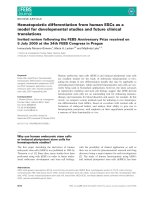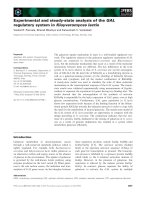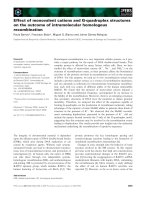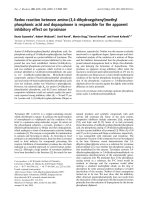Annuities and Other Retirement Products: Designing the Payout Phase (Directions in Development)_5 doc
Bạn đang xem bản rút gọn của tài liệu. Xem và tải ngay bản đầy đủ của tài liệu tại đây (397.54 KB, 23 trang )
9
One by two directional spreads 99
One of our clients was a a trader for a major hedge fund who got caught
out on a put 1×2. He began to cover their risk by selling futures. Then the
other players in the market needed to sell futures in order to cover their
risk. The market went down and down. Traders were ringing us up, asking
‘What’s going on? This don’t make sense.’ Finally the spread-arbs stabi-
lised the market, but our client had lost big, and he was furious.
There were phone calls and meetings, but fortu-
nately it didn’t get ugly. In the end he forgave us
our sins because he accepted that the broker made
an honest mistake. (Like not knowing what he
was doing.) The lesson is: either you work with an
options strategist or you stick to 1×1s, long vanil-
las, and butterflies or condors.
Either you work with
an options strategist or
you stick to 1×1s, long
vanillas, and butterflies
or condors
10
Combos and hybrid spreads for
market direction
Long call, short put combo or cylinder
Bullish strategy
Still another way of financing a long call position is to sell a put. Usually
both strikes are out-of-the-money, and this spread is called the long call,
short put combo. It is also called the cylinder. If
XYZ is at 100, you may buy the 110 call and sell
the 85 put in the same transaction. In order to trade
this spread, you must be reasonably certain that
the underlying is due to increase in value, because the short put incurs the
potential obligation to buy the underlying. The downside risk is great, but so
is the upside potential.
This spread is often traded by professionals who want to buy the underly-
ing. The long call serves as a buy-stop order, while the short put serves as a
resting buy order where value is estimated to be.
Consider the following:
Coca-Cola at 52.67
60 days until August expiration
Contract multiplier of $100
The August options are shown in Table 10.1.
Another way of financing
a long call position is
to sell a put
102 Part 2
Options spreads
Table 10.1 Coca-Cola August options
Strike
40.00 42.50 45.00 47.50 50.00 52.50 55.00 57.50 60.00
June
calls
4.04 2.52 1.45 0.79 0.34
June
puts
0.34 0.47 0.82 1.30 2.05 2.90
Data courtesy of the Chicago Board Options Exchange, CBOE.
Here, you could pay 0.79 for one August 57.50 call, and sell one August
45.00 put at 0.82 for a net credit of 0.03.
1
On the upside, the spread
behaves like a long 57.50 call sold for 0.03. The break-even level is the call
strike price minus the cost of the spread, or 57.50 – 0.03 = 57.47. You are
long a call, so you have unlimited upside potential.
On the downside, the spread behaves like a short 45 put for which you
receive a credit of 0.03. If at expiration, the stock closes below the put
strike, or 45, you will be assigned on the short put, and you will be obli-
gated to buy the stock at the strike price, or 45. The cost of your stock
purchase will be effectively reduced by the credit of the spread. For exam-
ple, if the stock closes at 45 and you are assigned on the put, the purchase
price of Coca-Cola would be 45 – 0.03 = 44.97. If the stock continues to
decline, you are still obligated to make purchase for an effective price of
44.97. Because of the naked, short put, the potential loss is large.
It is advisable to place the put at a greater distance from the underlying
than the call, unless you are convinced that the stock has bottomed out.
Use the technicals to find a support area.
If at expiration the stock closes between 45 and 57.50, the credit from the
spread, or 0.03 in this case, is earned. The expiration profit/loss is summa-
rised as follows:
Debit from August 57.50 call: –0.79
Credit from August 45 put: 0.82
–––––
Total credit: 0.03
Because you have traded this spread for a credit, there is no upside break-
even level.
1
The credit earned from this spread is possible because of the positive put volatility skew.
This is often the case. But beware of taking too much credit from this spread.
10
Combos and hybrid spreads for market direction 103
Maximum upside profit: potentially unlimited
Downside potential purchase price: lower strike price minus credit from
spread: 45.00 – 0.03 = 44.97
Maximum downside loss: decline of stock below downside potential pur-
chase price: 44.97
Profit/loss between strikes: credit from spread: 0.03 profit between 45 and
57.50
The risk/return potential is, practically speaking, equal and great. In tabu-
lar form, the expiration profit/loss is shown in Table 10.2.
Table 10.2 Coca-Cola long August 57.50 call, short 45 put combo
Coca-
Cola
(below) 40.00 44.97 45.00 50.00 55.00 57.50 62.50 (above)
Spread
credit
0.03
Value of
spread at
expiration
(– full amt) –5.00 0.00 0.00 0.00 0.00 0.00 5.00 (unlimited)
Profit/loss
(– full amt) –4.97 0.00 0.03 0.03 0.03 0.03 5.03 (unlimited)
In graphic terms, the expiration profit/loss is shown in Figure 10.1.
42.5
4
6
8
2
0
–2
–4
–6
–8
37.5
40 45 47.5 50 52.5 55 57.5 60 62.5 65
+0.03
Figure 10.1
Expiration profit/loss relating to Table 10.2
104 Part 2
Options spreads
The long call, short put combo is often traded in bull markets, and espe-
cially bull markets in commodities that are starting from long-term
support levels.
Long put, short call combo, or fence
Bearish strategy
A more common use of this spread is with a long
out-of-the-money put coupled with a short out-of-
the-money call, known as the long put, short call
combo. It is also called the cylinder or the collar.
If XYZ is at 100, you could buy one 95 put and sell
one 110 call in the same transaction. Both options
positions are a potential sale of the underlying.
This spread is often used as a hedge by investors who own or are long an
underlying contract. They want their cash back if the market declines, but
they want to take their profit if the market rallies. The long put acts as
a stop-loss order on their underlying position while the short call acts as
a resting sell order at a favourable price. When used in this manner this
spread is called the fence.
2
The call and the put can be placed at whatever levels are desirable, but
often 10 per cent out-of-the-money levels are used as a reference.
In Coca-Cola you could pay 1.30 for one Auggie 47.50 put and sell one
Auggie 60 call at 0.34 for a net debit of 0.96. On the downside, your
spread behaves like a long 47.50 put purchased for 0.96. Your break-even
level is the put strike minus the cost of the spread, or 47.50 – 0.96 = 46.54.
Below this level you profit one to one with the decline of the stock, or you
hedge your investment one to one.
On the upside, your spread behaves like a short 60 call for which you have
paid 0.96. If the stock closes above 60 at expiration, you will be assigned
on your short call, and you will be obligated to sell the stock at 60. The
spread was traded for a debit of 0.96, so your effective sale price would be
the call strike minus the spread debit, or 60 – 0.96 = 59.04. No matter how
far the stock rises above 60, you will still be obligated to sell it for an effec-
tive purchase price of 59.04. The loss, as with any short call position, is
potentially unlimited. You had better own the stock.
A long out-of-the-money
put coupled with a short
out-of-the-money call,
known as the long put,
short call combo
2
I've even heard of this spread referred to as the ‘collar’. Again, omit the jargon. Instead
say ‘I want to buy [this] option and sell [that] option as a spread.’
10
Combos and hybrid spreads for market direction 105
At expiration, if the stock closes between the strike prices, the spread debit
is taken as a loss. Here, if the stock closes between 47.50 and 60, the loss
on the position is 0.96.
A summary of the expiration profit/loss is as follows:
Debit from long August 47.50 put: –1.30
Credit from short August 60 call: 0.34
–––––
Total debit: –0.96
Downside break-even level: put strike minus cost of spread:
47.50 – 0.96 = 46.54
Maximum downside profit: decline of stock below lower break-even level:
46.54
Upside potential sale price: higher strike minus debit from spread:
60 – 0.96 = 59.04
Maximum upside loss: potentially unlimited
Profit/loss if stock closes between strikes: loss of spread debit: 0.96
Again, the risk/return potential, practically speaking, is equal and great.
The expiration profit/loss is shown in Table 10.3.
Table 10.3 Coca-Cola August long 47.50 put, short 60 call combo
Coca-
Cola
(below) 42.50 46.54 47.50 60.00 62.50 65.00 (above)
Spread
debit
–0.96
Value of
spread at
expiration
(full amt) 5.00 0.96 0.00 0.00 –2.50 –5.00 (–unlimited)
Profit/loss
(full amt) 4.04 0.00 –0.96 –0.96 –3.46 –5.96 (–unlimited)
Figure 10.2 shows a graph of this combo.
If you were the owner of Coca-Cola stock, and if you applied this spread
as a fence, then your effective selling levels at expiration would be either
46.54 or 59.04.
106 Part 2
Options spreads
Directional hybrid spreads
The directional spreads that we have discussed are the most common, but
they are not the only choices available. Many investors create spreads that
combine components of the standard spreads to
suit a particular outlook and strategy. There are
no special terms for these hybrid spreads, but they
can be traded in one transaction on most, if not
all, open-outcry exchanges. You may not trade
these spreads, but you might review them in order
to improve your options awareness.
As with all spreads, a hybrid can be created provided your outlook
accounts for:
O
direction
O
level of support
O
level of resistance.
The risk/return potential should also be assessed, and any contingency
plans prepared. The following is just one example of a hybrid spread.
Bullish strategy
If a call purchase can be financed by the sale of a put, then a call spread
purchase can be financed by the sale of a put. If XYZ is at 100, you could
buy the 105–115 call spread and sell the 85 put. On most open-outcry
45
4
6
8
2
0
–2
–4
–6
–8
40
42.5
47.5 50 52.5 55 57.5 60
62.5 65
Figure 10.2
Expiration profit/loss relating to Table 10.3
Many investors create
spreads that combine
components of the
standard spreads to
suit a particular
outlook and strategy
10
Combos and hybrid spreads for market direction 107
exchanges, this three-way can be traded in one transaction, and the bid–
ask spread for it will be marginally greater than with a single option.
The advantage of this spread is that the long call is financed with two
options, but the disadvantage is that the short put contains the potential
obligation to purchase the underlying if the market declines. Also, the
upside is limited.
With Coca-Cola at 52.67, you could pay 1.45 for one August 55 call, sell
one August 60 call at 0.34, and sell one August 45 put at 0.82 in the same
transaction for a net debit of 0.29. The profit range is 5 points at a cost of
0.29. Compare this to the August 55–60 spread, which has the same profit
range at a cost of 1.11. The three-way must account for the naked short
put, however. Here, your technical analysis tells you that there is support
at 45.
The upside of this spread behaves like a long 55–60 call spread purchased
for a cost of 0.29. The break-even level at expiration is the lower strike plus
the cost of the spread, or 55 + 0.29 = 55.29.
The maximum upside profit is the difference between the call strikes
minus the cost of the spread, or (60 – 55) – 0.29 = 4.71.
The downside of this spread behaves like a short 45 put traded for a debit
of 0.29. If the stock closes below 45 at expiration, you will be assigned on
the short put, and you will be obligated to pay 45 for the stock. Because
your spread was traded for a debit of 0.29 your effective purchase price
will be the strike price of the put plus the cost of the spread, or 95 + 0.29
= 95.29. No matter how far the stock declines below 95, you will still be
obligated to purchase it for an effective cost of 95.29. Because of the naked
short put, the potential loss is great.
If at expiration the stock closes between the middle strikes of the spread,
or 45–55, a loss is taken equal to the cost of the spread, or 0.29. A sum-
mary of the profit/loss at expiration follows.
Debit from long August 55 call: –1.45
Credit from short August 60 call: 0.34
Credit from short August 45 put: 0.82
–––––
Total debit: –0.29
Upside break-even level: lower call strike plus cost of spread: 55 + 0.29 = 55.29
Maximum upside profit: difference between strikes minus cost of spread:
(60 – 55) – 0.29 = 4.71
108 Part 2
Options spreads
Potential downside purchase price: put strike plus cost of spread:
45 + 0.29 = 45.29
Maximum downside loss: full extent of the stock’s decline below 45.29
Profit/loss if stock closes between the middle two strikes (55–60) is the cost
of the spread, or 0.29 loss
Like the combo, this three-way is occasionally traded at the beginning of
bull markets in commodities, when long-term support levels are well estab-
lished. There are many other hybrids which are traded less often. The more
sophisticated traders are continually inventing new ways to spread options.
11
Volatility spreads
Market volatility
Options differ from most other investment prod-
ucts because they address market volatility.
1
Volatility is a function of absolute price move-
ment, i.e. price fluctuations in either direction.
Options can be traded to profit from either
increasing or decreasing absolute movement. Often the price trend of an
underlying is more difficult to assess than its volatility trend. When this is
the case, volatility spreads are preferable.
If the volatility is increasing, we can often assume that the underlying
is expanding its range, and that it will be significantly higher or lower
at expiration than it is at present. The risk of our assumption is that the
underlying may increase its range but that at expiration it may settle at
the midpoint.
If the volatility is decreasing, we can often assume that the underlying will
be within its recent range at expiration. The risk of our assumption is that
the underlying may decrease its range but that by expiration the range
itself may shift to a higher or lower level.
If we wish to trade volatility, we can take positions that profit from either
increasing or decreasing absolute movement. In more conventional terms,
we say that we can take positions to profit from either volatile or station-
ary markets. By convention, the word ‘volatile’ means high volatility, and by
1
This chapter should be read in conjunction with Chapter 4, ‘Volatility and pricing
models’.
Options can be traded
to profit from either
increasing or decreasing
absolute movement
110 Part 2
Options spreads
convention, the word ‘stationary’ means low volatility. These conventional
terms may not be precise, but now that we know their limitations, we can
use them. Therefore, for our purpose we can set out the following definitions:
O
Volatile means increasing absolute price movement, high absolute
price movement, increasing historical and implied volatility, and high
historical and implied volatility.
O
Stationary means decreasing absolute price movement, low absolute
price movement, decreasing historical and implied volatility, and low
historical and implied volatility.
Spreads for volatile markets, such as the long straddle, profit from
increased volatility, both historical and implied. They incur a cost from
time decay. They may or may not be net long options. They have net
positive vega, positive gamma and negative theta. These spreads are best
opened when the market is quiet, or emerging from quiet conditions, and
when absolute movement is expected to increase.
Spreads for stationary markets, such as the long at-the-money butterfly,
profit from decreased volatility, both historical and implied. They profit
from time decay. They may or may not be net short options. They have
net negative vega, negative gamma and positive theta. These spreads are
best opened when the market has been active, and when absolute move-
ment has started to decrease.
The same spread can often be traded in either volatile or stationary mar-
kets, depending on whether it is bought or sold. Practically speaking,
some of these spreads are more suitable for the first or the second type of
market, and some have more inherent risks. All beginners should trade the
spreads with the least risk, and these are marked with an asterisk (*).
At some point, you may benefit from reviewing this introduction.
Long straddle
For volatile markets
The long straddle is a simultaneous purchase of the at-the-money call and
put. This spread profits when the underlying, at expiration, has increased
or decreased to a level that more than compen-
sates for its cost. If XYZ is at 100, you could buy
the 100 call and the 100 put in the same transac-
tion. The maximum risk of the spread is its cost,
The long straddle is a
simultaneous purchase
of the at-the-money
call and put
11
Volatility spreads 111
and the potential return is the full amount that the underlying increases
or decreases above the upside, or below the downside, break-even levels.
Consider the following April options on Marks and Spencer:
Marks and Spencer at 350.60
30 days until April expiry
Contract multiplier is £1,000
Table 11.1 Marks and Spencer April options
Strike
310.00 320.00 330.00 340.00 350.00 360.00 370.00 380.00
Apr calls
17.00 11.25 6.75 3.75 2.00
Apr puts
1.00 2.00 3.75 6.25 10.25 16.25
Settlement prices courtesy of NYSE Euronext Liffe.
Here, you could purchase the April 350 straddle by paying 11.25p for the 350
call and 10.25p for the 350 put in a single transaction, for a total debit of
21.50p (£215). This debit is your maximum risk. With this spread you have
the right to buy the shares at 350; also the right to sell the shares at 350.
At expiry, the upside break-even level is the strike price plus the cost of
the spread, or 350 + 21.50 = 371.50. The downside break-even level is the
strike price minus the cost of the spread, or 350 – 21.50 = 328.50.
Above 371.50 the spread profits point for point with an increase in the
stock price, and the maximum return is potentially unlimited. Below
328.50 the spread profits point for point with a decline in the stock price,
and the maximum return is the full extent of the shares’ decline. (There
are probably buyers for Marks and Spencer before it gets to zero.)
Between the break-even levels, a partial loss is taken. On the upside, this
equals the share price, minus the strike price, minus the cost of the spread.
In this case, if the shares at expiry close at 370, the loss would be (370 –
350) – 21.50 = –1.50. On the downside, the partial loss equals the strike
price, minus the share price, minus the cost of the spread. In this case, if the
shares close at 330, the loss would be (350 – 330) – 21.50 = –1.50.
The expiry profit/loss is summarised as follows:
112 Part 2
Options spreads
Debit from long April 350 call: –11.25
Debit from long April 350 put: –10.25
––––––
Total debit: –21.50
Upside break-even level: strike price plus cost of spread: 350 + 21.50 = 371.50
Downside break-even level: strike price minus cost of spread:
350 – 21.50 = 328.50
Maximum upside profit: potentially unlimited
Maximum downside profit: amount that stock declines below lower
break-even level: 328.50
Maximum risk : cost of spread: 21.50
In order to determine the risk/return potential of this spread, you must
consider the cost of the spread versus the potential for absolute price
movement of the stock. In tabular form, the expiration profit/loss is as in
Table 11.2.
Table 11.2 Marks and Spencer long April 350 straddle
M&S
(below) 320.00 328.50 340.00 350.00 360.00 371.50 380.00 (above)
Spread
debit
–21.50
Value of
spread
at
expiry
(full
amt)
30.00 21.50 10.00 0.00 10.00 21.50 30.00 (unlimited)
Profit/
loss
(full
amt)
8.50 0.00 –11.50 –21.50 –11.50 0.00 8.50 (unlimited)
A profit/loss graph of this spread at expiry is as shown in Figure 11.1.
The long straddle has the total positive vega of the call plus the put. It is
extremely sensitive to a change in the implied volatility. If the underly-
ing starts to move, and the implied volatility starts to increase, this spread
profits on two accounts: direction and increased implied.
This spread has double the gamma of a single at-the-money call or put. If
the market rallies, the increase of the call delta accelerates, the decrease of
the put delta accelerates, and the spread gets longer quickly. If the market
breaks, the spread gets shorter quickly for the opposite reasons.
11
Volatility spreads 113
The risk, or the trade-off, of the long straddle is that the market may stay
in its present range, and that the implied volatility may decrease while
time decay depreciates the investment. Remember that with at-the-money
options time decay accelerates in the period of 60–30 days until expira-
tion. The risk here is double that of a single at-the-money option, and even
greater than with an out-of-the-money option. It is therefore advisable to
take a long straddle position that is half the size of your usual position.
The long straddle is the most expensive options spread, and so it requires
a great deal of market movement in order to profit. It can pay off hand-
somely, or it can result in a big let-down.
Many traders buy straddles in anticipation of a short-term spike in volatil-
ity – for example, if an event is foreseen. Then a bit of market movement
is a bonus. They sell their straddle quickly after the event, before time
decay reduces their profit.
In this example, time decay is severe with 30 days until expiry, so in
order to buy this straddle, you would need to be confident that Marks
and Spencer is due for a big move, and that the options were due for an
increase in implied volatility.
A spread that profits from volatile markets but that has less risk than the
long straddle is the long iron butterfly (discussed in Chapter 12).
330
5
10
15
20
25
0
–5
–10
–15
–20
–25
310
320 340 350 360 370 380 390
Figure 11.1
Expiration profit/loss relating to Table 11.2
114 Part 2
Options spreads
Short straddle
For stationary markets
The short straddle is the opposite position of the long straddle, i.e. a
simultaneous sale of the at-the-money call and put. If XYZ is at 100, you
could sell both the 100 call and the 100 put. The
risk/return characteristics are also opposite to the
long straddle. The maximum return is the amount
of the premium collected; the potential loss is
unlimited. In order to sell the straddle, you must
be convinced that the underlying will not exceed
the range covered by the premium income, or the
break-even levels, at expiration. You must also
be prepared to meet large margin calls if the position goes against you.
Because the potential risk is unlimited it is not advisable to sell the straddle
until you are an experienced options trader.
Because the straddle is the most expensive options spread, it is often a
tempting sale, and it is often profitable. It is justifiable only when prob-
ability is on the seller’s side. Assessing probability is difficult, but the
volatility trends are the most helpful guides.
The expiry profit/loss for the short straddle can be summarised by making
the opposite calculations of the previous long straddle. This summary is
as follows:
Credit from long April 350 call: 11.25
Credit from long April 350 put: 10.25
–––––––
Total credit: 21.50
Upside break-even level: strike price plus credit from spread:
350 + 21.50 = 371.50
Downside break-even level: strike price minus credit from spread:
350 – 21.50 = 328.50
Maximum upside loss: potentially unlimited
Maximum downside loss: amount that stock declines below lower
break-even level: 328.50
Maximum profit: income from spread: 21.50
The short straddle is the
opposite position of the
long straddle, i.e.
a simultaneous sale
of the at-the-money
call and put
11
Volatility spreads 115
The risk/return potential of this spread must be evaluated in terms of its
income versus a loss that is potentially unlimited. In tabular form, the
expiry profit/loss is as shown in Table 11.3.
Table 11.3 Marks and Spencer short April 350 straddle
M&S
(below) 320.00 328.50 340.00 350.00 360.00 371.50 380.00 (above)
Spread
credit
21.50
Value of
spread
at expiry
(full
amt)
–30.00 –21.50 –10.00 0.00 –10.00 –21.50 –30.00 (unlimited)
Profit/
loss
(full
amt)
–8.50 0.00 11.50 21.50 11.50 0.00 –8.50 (unlimited)
In graphic form, the expiry profit/loss is as shown in Figure 11.2.
Again, many traders sell the straddle to profit from a short-term decline in
volatility. Their view is that a forthcoming event will be a non-event. For
example, if the US non-farm payrolls are reported as expected, then volatil-
ity may get crushed, and the straddle sellers quickly buy their straddles back.
330
5
10
15
20
25
0
–5
–10
–15
–20
–25
310
320 340 350 360 370 380 390
Figure 11.2
Expiration profit/loss relating to Table 11.3
116 Part 2
Options spreads
Two similar spreads that profit from stationary markets but that have lim-
ited risk are the long at-the-money butterfly (discussed in Chapter 13)
and the short iron butterfly (discussed in Chapter 12). They are among
the spreads recommended for stationary markets.
Long strangle
For absolute market movement
The long strangle is the simultaneous purchase of an out-of-the-money
call and put. Both the options are equidistant from the underlying. If
XYZ is at 100, you could buy the 90 put and buy
the 110 call in the same transaction. This spread
is similar to the long straddle but costs less. The
break-even levels are more distant from the under-
lying, and while there is less potential profit, there
is also less risk.
Using the preceding set of Marks and Spencer April options, you could pay
6.75 for one 360 call and pay 6.25 for one 340 put in the same transaction
for a total debit of 13p (£130) This debit is your maximum risk.
At expiry, the upside break-even level is the higher strike price plus the
cost of the spread, or 360 + 13 = 373. The downside break-even level is the
lower strike price minus the cost of the spread, or 340 – 13 = 327.
Like the long straddle, this spread profits the full amount that the stock
closes outside the break-even levels at expiration. If the stock closes
between the strike prices, the cost of the spread is taken as a loss. Between
the strike prices and the break-even levels, a partial loss is taken.
The expiry profit/loss for this spread is summarised as follows:
Debit from long April 360 call: –6.75
Debit from long April 340 put: –6.25
––––––
Total debit: –13.00
Upside break-even level: upper strike price plus cost of spread: 360 + 13 + 373
Downside break-even level: lower strike price minus cost of spread:
340 – 13 = 327
Maximum upside profit: potentially unlimited
The long strangle is the
simultaneous purchase
of an out-of-the-money
call and put
11
Volatility spreads 117
Maximum downside profit: amount of stock decline below lower
break-even level: 327
Maximum risk: cost of spread: 13
In order to determine the risk/return potential of this spread, you must
weigh its cost against the potential for the shares to move outside the
break-even levels. The expiry profit/loss is as shown in Table 11.4.
Table 11.4 Marks and Spencer long April 340–360 strangle
M&S
(below) 320.00 327.00 340.00 350.00 360.00 373.00 380.00 (above)
Spread
debit
13.00
Value
of
spread
at
expiry
(full
amt)
20.00 13.00 0.00 0.00 0.00 13.00 20.00 (unlimited)
Profit/
loss
(full
amt)
7.00 0.00 –13.00 –13.00 –13.00 0.00 7.00 (unlimited)
The expiry profit/loss is shown in Figure 11.3.
As a spread for volatile markets, the long strangle can be placed at any dis-
tance from the underlying. The closer both strikes are to the underlying,
the more this spread behaves like a long straddle, with increased exposure
330
5
10
15
20
0
–5
–10
–15
310
320 340 350 360 370 380 390
Figure 11.3
Expiration profit/loss relating to Table 11.4
118 Part 2
Options spreads
to time decay (via negative theta), and increased exposure to a decline in
implied volatility (via positive vega). Because the maximum risk of this
spread is known at the outset, it is not inadvisable to trade it, but because
of the premium exposure, and because only one of the strikes is likely to
profit, the risk may be unjustifiable for some investors. A similar spread
with less premium risk is the long iron condor, discussed in Chapter 12.
The long strangle is preferable as a trade to profit from increasing implied
volatility. If the current implied is low and/or increasing, this spread has
an additional return scenario. It is therefore justifiable in itself, regardless
of direction, and the wings, or each strike, can be placed far-out-of-the-
money. As with all long volatility positions, the days until expiration
should be more than 60.
Short strangle
For stationary markets
The strangle is more often used as a short spread to profit from decreas-
ing implied volatility. The short strangle is too often traded simply to gain
income from time decay, which is a dangerous misapplication, as we have
already seen.
The short strangle has, like the short straddle,
theoretically unlimited risk, but because the two
strikes are at greater distances from the underly-
ing, it is more manageable strategy. The positive
theta, or the daily income from time decay, is
not as great, but the negative vega, or exposure to
increased implied volatility, is also not as great.
Because of the two short, naked options, it is advisable not to trade this
spread until you have gained experience. A similar spread for stationary
markets with less risk is the short iron condor, which is also discussed in
Chapter 12.
Using the set of Marks and Spencer April options, a typical short strangle
would be a sale of the 330 put at 3.75 and a sale of the 370 call at 3.75 in
the same transaction, for a total credit of 7.50 (£75).
At expiry, the upside break-even level is the upper strike price plus the
income from the spread, or 370 + 7.50 = 377.50. Above this level the
potential loss is unlimited. The downside break-even level is the lower
strike price minus the income from the spread, or 330 – 7.50 = 322.50.
Below this level the potential loss is the full value of the stock. The expiry
profit/loss is summarised as follows:
The strangle is more
often used as a short
spread to profit
from decreasing
implied volatility
11
Volatility spreads 119
Credit from April 370 call: 3.75
Credit from April 330 put: 3.75
–––––
Total credit: 7.50
Upside break-even level: higher strike plus income from spread:
370 + 7.50 = 377.50
Downside break-even level: lower strike minus income from spread:
330 – 7.50 = 322.50
Maximum loss: potentially unlimited
Maximum profit: income from spread: 7.50
The expiry profit/loss is shown in Table 11.5.
Table 11.5 Marks and Spencer short April 330–370 strangle
M&S
(below) 310.00 322.50 330.00 350.00 370.00 377.50 390.00 (above)
Spread
credit
7.50
Value
of
spread
at
expiry
(full
amt)
–20 –7.50 0.00 0.00 0.00 –7.50 –20.00 (unlimited)
Profit/
loss
(full
amt)
–12.50 0.00 7.50 7.50 7.50 0.00 –12.50 (unlimited)
Figure 11.4 is a graph of the profit/loss at expiry.
330
5
10
0
–5
–10
–15
310
320 340 350 360 370 380 390
Figure 11.4
Expiration profit/loss relating to Table 11.5
12
Iron butterflies and iron
condors: combining straddles
and strangles for reduced risk
Often the risk of unlimited loss from being short two naked options
cannot be justified. This is especially true for new traders. Occasionally,
the risk of premium loss from being long two
options cannot be justified. By combining
straddles and strangles, you can take the same
approaches to volatile or stationary markets, but
you can quantify and limit your risks. Your poten-
tial returns may not be as great, but you can sleep more soundly, and
you’ll be easier to live with. The following spreads all have more manage-
able risk.
Again, all these spreads can be traded in one transaction on most
exchanges. Their bid–ask market should be marginally greater than that of
a single option.
* Long iron butterfly
For absolute market movement
A long straddle can be financed by the sale of a strangle. If XYZ is at 100,
you could buy the 100 straddle and simultaneously sell the 90–110 stran-
gle in order to create the long iron butterfly. You can also think of this
spread as a long at-the-money call spread at the 100 and 110 strikes, plus a
long at-the-money put spread at the 100 and 90 strikes.
Compared to the long straddle, this spread has reduced premium expo-
sure, but it also has reduced potential return.
Occasionally, the risk
of premium loss from
being long two options
cannot be justified

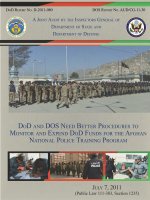
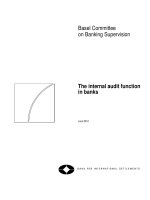

![Báo cáo khóa học: Selective release and function of one of the two FMN groups in the cytoplasmic NAD + -reducing [NiFe]-hydrogenase from Ralstonia eutropha pptx](https://media.store123doc.com/images/document/14/rc/gg/medium_ggg1394180403.jpg)

